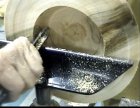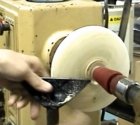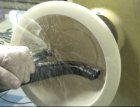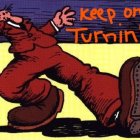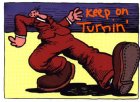robohippy,
It is not a video, it is a text review.
this is the link
https://www.thedailygardener.com/wood-lathe-tool-rest
sorry about the confusion
To all others have has replied to my thread:
Thank you!! I appreciate your suggestions and info.
The reason I like the the 5/8” round toolrest size is that I am mainly interested in spindle turning using either a cup (safety) or spur drive center, thus I do not think a heavy duty tool rest is needed. (I have two Nova chucks with various jaws but I seldom use them – bought them very early on because I thought they were essential to my type of turning (small lidded boxes and hollow forms) .
I feel the same as Alan Lacer in that you will be a better turner if you learn to turn with a safety drive center. sharp tools, proper technique, and alight touch. I think that learning to turn this way you really get to know how to use your tools, while preventing a dangerous catch.
Another reason I like a 5/8” toolrest is that my wood-turning interests are are small lidded boxes/hollow forms, Xmas and birdhouse ornaments, medallions,pendants, Tops, and miniatures. I feel that none of these place a heavy load on the tool rest. I am also like to design and make various specialty turning tools, accessories, and jigs /fixtures that are useful for my type of turning,
I don't want to buy a lot o f turning accessories that I think a might like, but that I may never or or seldom use and thus end up having to return them. I have been that route before in wood turning and my other interests/hobbies and ended up with some stuff I never or seldom used because they were not as use full for me as advertised The Srby Turnmaster, Wolverine Grinding Jig ,Vary-grind2, and a CBN wheel are some examples. I now use the Sorby ProEdge Sharpening system. Also as fae as I am concerned, the cheaper non-Sorby ceramic belts for the ProEdge system were a waste of money, In my opinion they are not the same quality as the Sorby belts in grain size/distribution (they seem to be rougher, thicker, and not as flexible as the Sorby belts).
Turning is a very relaxing part-time hobby for me. That and the ease of access are two of the reasons my min-lathe and my Sherline meta lathe are both located in the master bathroom of my house , not not in my Wood / Metal shop building (my wife died 15 years ago, so that was not a consideration).
I reread my initial reply and hope I did not leave the impression that I am a Miser. I am not above spending money on quality accessories. However , have learned over the years that I want to ether inspect, use, or have a live demonstration (with questions) before buying. Exceptions are items of known quality and use, such as the Crown Spindle gouge I bought two weeks ago. Demos on you tube and the internet are wonderful and valuable, but watching an expert demonstrate is far different from actually trying to do it yourself. A good example is using the Wolverine grinding jig to sharpen, especially if your eyesight is no longer what it used to be.
Unfortunately the nearest wood working/turning store (Woodcraft) is a 160+ mule round trip.
By the way I do use Epoxy quite a bit, but it and superglue does have their limitations.Brazing creates a much stronger joint. To date, I have only brazed hardened ejection mold guide pins and they seem to remain hardened (at least a file can't touch it). In brazing you only melt the brazing filler metal, not the metal(s) you try to join. W welding melts the two metal(s) together.

